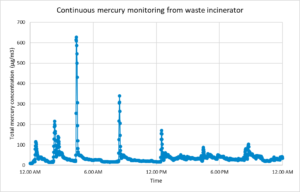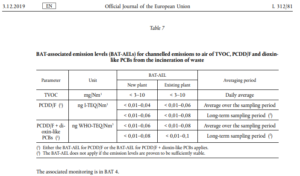
WI BAT conclusions published – key findings in emissions monitoring
The final draft of the Best Available Technology Reference document for Waste Incineration (WI BREF) was accepted by European Integrated Pollution Prevention and Control Bureau (EIPPCB) on summer 2019 and the WI BAT conclusions published on 3rd December 2019, under the IED Directive 2010/75/EU. This BAT conclusions covers the incineration and co-incineration of waste, including the following waste categories: municipal waste, other non-hazardous waste, sewage sludge, hazardous waste and clinical waste.
The main aim of the WI BAT conclusions is to reduce both air and water emissions from different waste installations.
The BAT Conclusion has been published in the Official Journal of the European Union.
BAT-Associated Emission Levels and Implementation Period
The revised BREF defines the technical basis and BAT-associated emission levels (BAT-AELs) for national authorities in the EU to set operating permits for installations. The BAT-AELs work as a framework for authorities to set plant-specific ELVs, i.e. Emissions Limit Values.
Regardless of whether the BAT-AELs change or not, all environmental permits of existing waste incineration installations in Europe need to be reviewed during the implementation period of four years. This may cause changes in the plant-specific ELVs (within the limits defined by the BAT-AELs).
New installations must comply with the new requirements immediately without any implementation period. In different countries and plants, the specific ELVs may be different even though all these need to be according to BAT-AEL requirements.
(Existing installation i.e. first permitted before the publication of the BAT conclusions)
(New installation i.e. first permitted after the publication of the BAT conclusions)
Key Findings for Emissions Monitoring
Key findings for emissions monitoring in the BAT conclusions for Waste Incineration (see table below):

(Source: https://eur-lex.europa.eu/legal-content/EN/TXT/PDF/?uri=CELEX:32019D2010&from=EN)
The BAT-AELs set for mercury (Hg) emissions for incineration and co-incinerations of waste happens for the first time at the EU level. Continuous monitoring is required if it cannot be proven that the waste incinerated has low and stable mercury content.
The mercury content of different waste feeds can vary significantly, which can be clearly spotted with continuous mercury monitoring. During the day, the new feed is introduced approximately every four hours, resulting in mercury peaks as the waste is incinerated (see the Graph below).

In addition, the BAT Conclusions for Waste Incineration sets new BAT-AELs for the following compounds: TVOC/PCDD/F and dioxin-like PCBs (see Table below).

(Source: https://eur-lex.europa.eu/legal-content/EN/TXT/PDF/?uri=CELEX:32019D2010&from=EN)
Gasmet offers complete solutions for monitoring industrial emissions to air:
Continuous Mercury Monitoring system – CMM AutoQAL
The Continuous Mercury Monitoring system, the CMM AutoQAL, is a complete emission monitoring system designed to meet the regulations for continuous mercury measurement standards. The system has the world’s lowest EN15267 certified range (0 to 5 µg/m3) for measurements of Mercury and the lowest measurement uncertainty in the world. The lowest uncertainty of the system secures the highest measurement accuracy in the field of Hg monitoring, even in case of very high Hg concentrations.
The use of Gasmet Continuous Mercury Monitoring systems have been successfully tested for combustion plants, waste incineration, and cement plants.
Read more about our Continuous Mercury Monitoring system.
Continuous Emissions Monitoring system – CEMS II e
Gasmet Continuous Emissions Monitoring System CEMS II e offers TÜV and MCERTS certified solution (QAL1) for a wide range of demanding emission monitoring applications. Gasmet CEMS II e is generally used to simultaneously measure the following 16 gases: H2O, CO2, CO, N2O, NO, NO2, SO2, HCl, HF, NH3, CH4, C2H6, C3H8, C2H4, C6H14 and CH2O. The Continuous Emissions Monitoring system (CEMS II e) is fully automatic system and it is specifically designed to increase flexibility. The Gasmet CEMS II e has an excellent annual availability and 6-month maintenance interval.
Read more about our Continuous Emissions Monitoring system.
Continuous Dioxin Sampling system – GT90 Dioxin+
This MCERTS certified system for dioxin monitoring is a device designed for long-term monitoring of dioxin emissions in conformity to the European standard EN1948-1 and EN15267. The system represents the cutting-edge technology for dioxin sampling and fulfils all the requirements of the dioxin measurement standard.
The MCERTS certified system for continuous sampling of dioxin emissions was designed for automated emissions monitoring of hazardous organic compounds in industrial and domestic waste incineration plants. In addition to dioxins, the system is capable of measuring furans and other persistent organic pollutants (POPs) such as polychlorinated biphenyls (PCBs) and polycyclic aromatic hydrocarbons (PAHs).